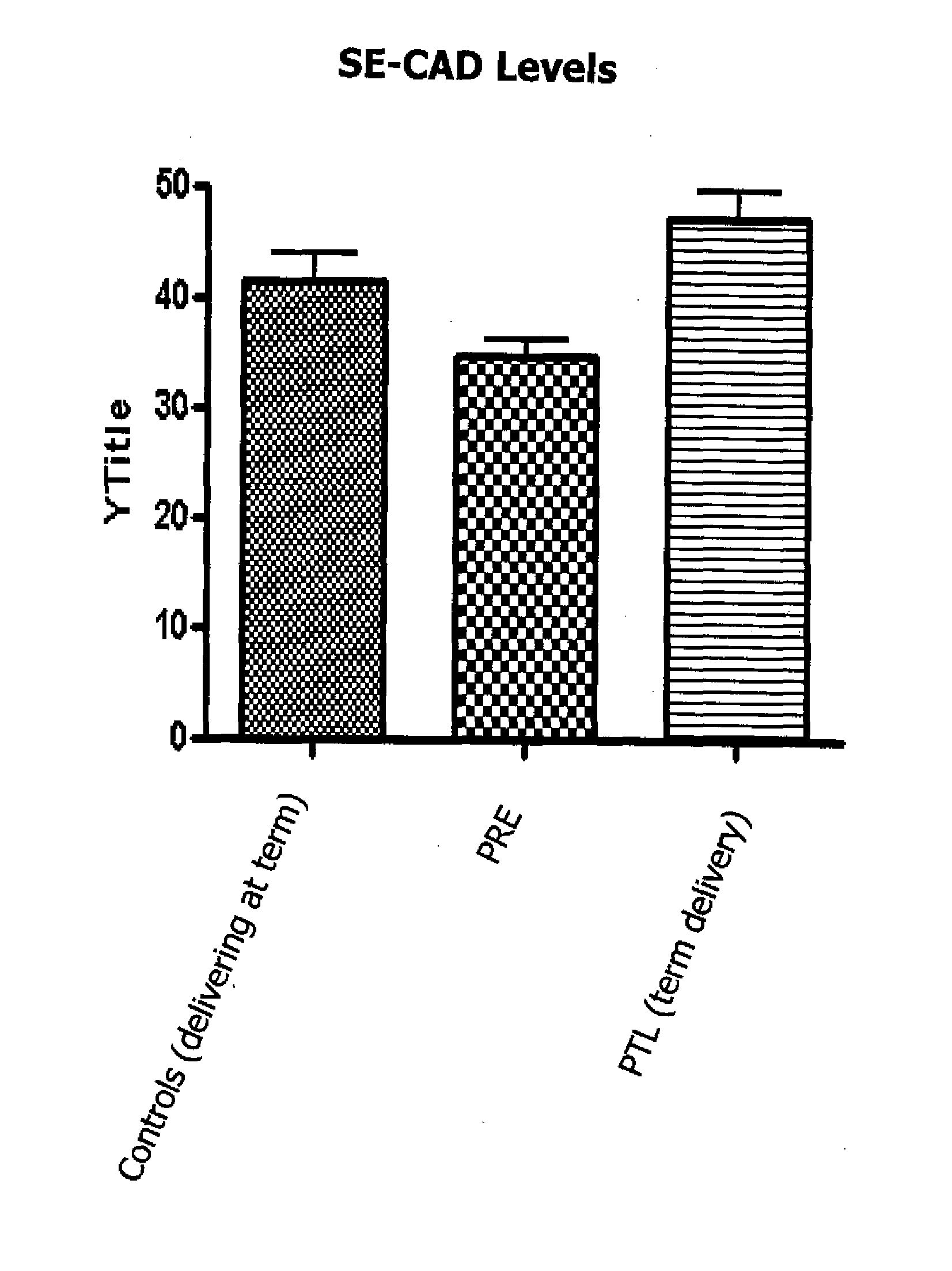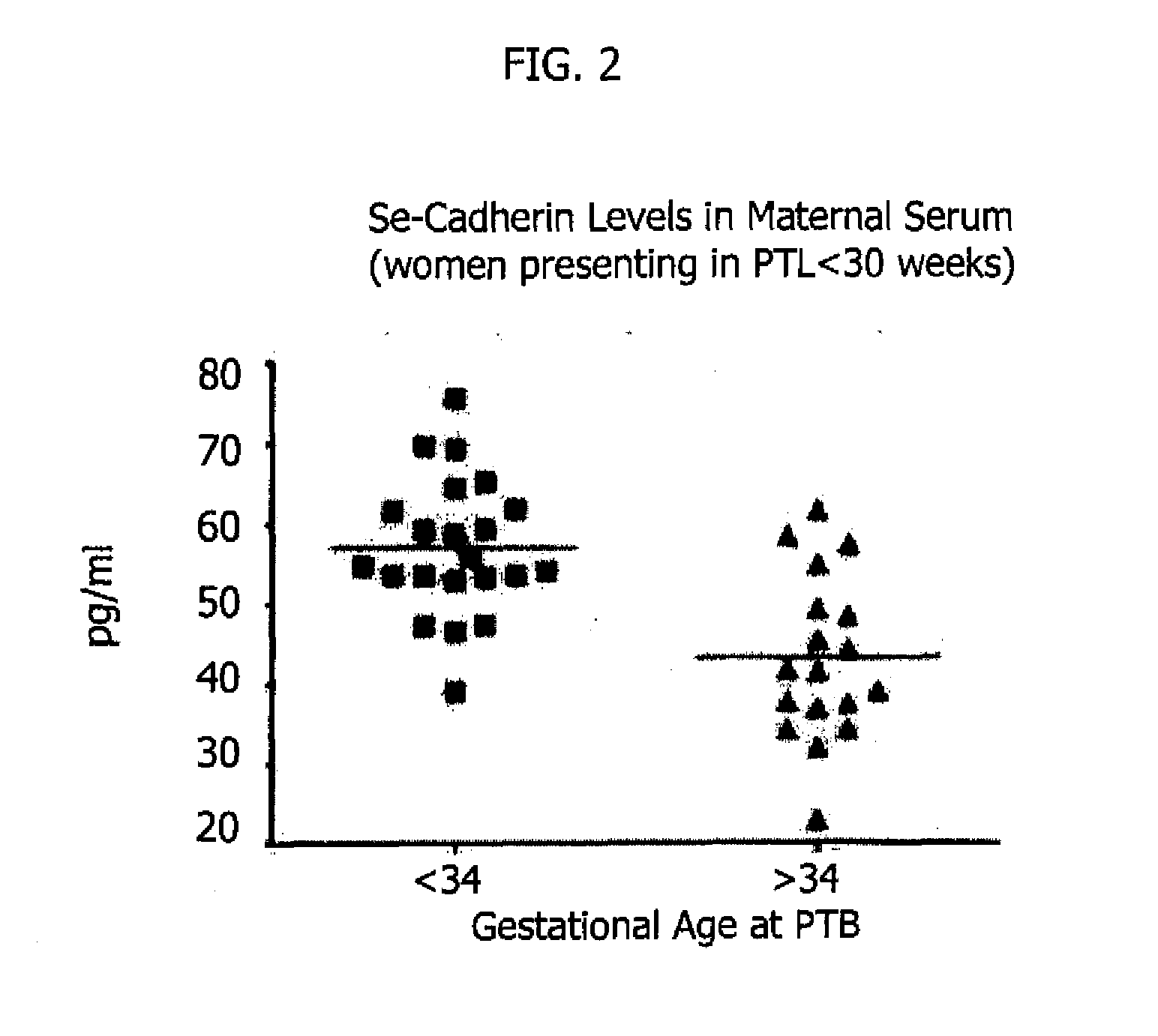Method of predicting risk of pre-term birth
a pre-term infant and risk prediction technology, applied in the field of pre-term infant risk prediction, can solve the problems of extreme cost of ptb residing not only in the immediate, neonatal mortality, and consume a significant proportion of children's health care costs, and achieve the effect of increasing the risk of ptb
- Summary
- Abstract
- Description
- Claims
- Application Information
AI Technical Summary
Benefits of technology
Problems solved by technology
Method used
Image
Examples
example 1
Preterm Parturition from Intrauterine Inflammation Results in Decreased Expression of E-cadherin in Cervical Tissues
[0060]In the examples herein, a mouse model of intrauterine inflammation16-18 was used in which lipopolysaccharide (a component of the cell wall of gram negative bacteria, LPS) is infused into the uterine horn. Dams deliver between 8-20 hours, with most delivering in 12 hours with no maternal mortality.14, 15, 19-21 Intrauterine inflammation is associated with premature cervical ripening that occurs prior to the clinical onset of parturition.16 Compared to controls, cervices from dams exposed to intrauterine LPS, had fewer collagen fibers, a less dense stroma, and an increase in mucin.16 Cervical ripening appears to be the initial event in the pathogenesis of inflammation-induced PTB.
[0061]The mouse model of intrauterine inflammation described above was employed and cervical tissues were harvested from dams exposed to LPS or saline at 2, 4 and 6 hours. Using QPCR, it ...
example 2
Term Parturition is also Associated with a Decrease in E-Cadherin mrna Expression as this Pathway in Cervical Remodeling is Hypothesized to be Common to all Parturition
[0062]E-cadherin mRNA expression was measured with QPCR in non-pregnant cervices, across gestation in timed-pregnant mice as well as postpartum. For this strain of mice, parturition occurs in a predictable time course on E19. “E#” refers to Embyonic Day in defining the gestation period of mice, where the first 24 hours of gestation are counted as E0. Therefore, the 12 hours prior to E19 (E18.5) represent the time just prior to term parturition. E-cadherin mRNA levels were significantly different between the groups (P=0.001, One Way ANOVA). Compared to non-pregnant levels, E-cadherin mRNA was increased on E15 (preterm; mid-gestation)(P=0.007, SNK). E-cadherin mRNA levels are decreased 4.3 fold on E18.5 compared to E15 (P=<0.001, SNK), which supports that expression of E-cadherin also occurs with term parturition,.
example 3
SE-Cadherin (SE-CAD) is Increased in Maternal Serum Prior to Delivery in a Mouse Model of Inflammation-Induced Preterm Birth
[0063]SE-CAD was measured in maternal serum at 2, 4 and 6 hours after intrauterine infusion of LPS or saline using the mouse model of Example 1. SE-CAD was measured using a commercially available ELISA (R&D Biosystems human E-CAD monoclonal antibody ELISA kit). As noted in FIG. 1, SE-CAD levels are significantly different between LPS and saline exposed dams (P=<0.001, One-Way ANOVA). SE-CAD levels continue to rise at six hours (prior to the clinical onset of parturition in this model). These data support that SE-CAD in the serum is a marker of E-cadherin break down specifically in the cervix, and that cervical remodeling can be detected systemically.
PUM
| Property | Measurement | Unit |
|---|---|---|
| Time | aaaaa | aaaaa |
| Length | aaaaa | aaaaa |
| Level | aaaaa | aaaaa |
Abstract
Description
Claims
Application Information
 Login to View More
Login to View More - R&D
- Intellectual Property
- Life Sciences
- Materials
- Tech Scout
- Unparalleled Data Quality
- Higher Quality Content
- 60% Fewer Hallucinations
Browse by: Latest US Patents, China's latest patents, Technical Efficacy Thesaurus, Application Domain, Technology Topic, Popular Technical Reports.
© 2025 PatSnap. All rights reserved.Legal|Privacy policy|Modern Slavery Act Transparency Statement|Sitemap|About US| Contact US: help@patsnap.com



